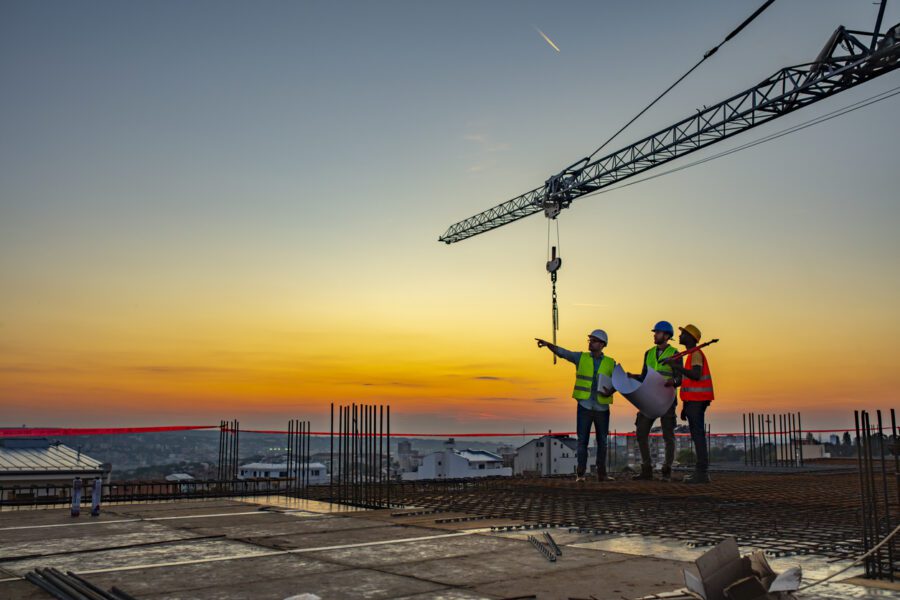
Safety in construction is paramount due to the industry’s high-risk nature. Workers are exposed to heavy machinery, heights, and unpredictable environmental conditions. Ensuring a safe working environment protects lives and enhances productivity and compliance with regulatory standards.
AI and computer vision technologies have revolutionized safety monitoring by providing real-time hazard detection, behavior analysis, and equipment monitoring. These advanced systems enable construction sites to proactively address potential safety issues, ensuring a safer and more efficient work environment for everyone involved.
1. Real-time hazard detection
AI detects potential hazards in real-time by leveraging advanced algorithms and computer vision to monitor construction sites for unsafe conditions. For instance, it can identify obstacles, unstable structures, or hazardous materials that might not be immediately apparent to human eyes.
This technology is crucial, given that the construction sector caused 46.2% of all fatal falls, slips, and trips in 2021. AI can instantly alert site managers and workers to these dangers, enabling immediate responses to safety threats. This practice significantly reduces the likelihood of accidents and improves overall site safety.
2. Worker behavior monitoring
AI systems track worker movements and behaviors using sophisticated sensors and computer vision technology to ensure compliance with safety protocols and identify risky actions. These systems monitor real-time activities, such as ensuring workers maintain proper distance from hazardous zones, use appropriate lifting techniques, and adhere to safety guidelines.
Analyzing patterns and flagging deviations allow AI to alert supervisors to potential safety breaches or unsafe practices. This proactive monitoring maintains a safe working environment and educates workers on safe practices. It also reduces the risk of accidents and injuries on construction sites.
3. Environmental monitoring
AI systems monitor environmental conditions on construction sites — including dust, noise, and air quality — to ensure a safe and compliant working environment. These systems can detect harmful levels of pollutants, excessive noise, or poor quality using sensors and real-time data analysis. This continuous monitoring alerts site managers to take corrective actions. This monitoring is crucial as frequent extreme weather can cause high-cost repairs and damages.
By maintaining optimal site conditions, AI helps prevent health issues for workers and ensures compliance with environmental regulations. For example, an AI application might continuously measure dust levels during construction activities, triggering water sprays to reduce airborne particles and protect worker health.
4. Personal protective equipment compliance
AI and computer vision technologies check for the proper use of personal protective equipment by using advanced algorithms to analyze visual data in real-time. These systems train robots to see and interpret visual information similarly to humans, observing and recognizing patterns they have never encountered.
Scanning workers as they enter and move around the site allows AI to verify whether they wear necessary safety gear, such as helmets, gloves, and vests. For example, the system finds a worker without a hard hat. It can instantly notify the site manager and ensure swift intervention to maintain safety standards.
5. Equipment and machinery safety
AI monitors the safe operation of equipment and machinery on construction sites by continuously analyzing data from sensors and cameras to ensure proper usage and prevent accidents. Between 2018 and 2020, contact with objects and equipment accounted for over 32% of total injuries in the construction sector, highlighting the need for effective monitoring.
AI systems can detect anomalies in machinery operation — such as overheating, unusual vibrations, or improper handling — and immediately alert supervisors to potential safety risks. For instance, an excavator is too close to a trench edge. The AI system can identify this unsafe practice and notify site managers to take corrective action.
6. Perimeter security and intrusion detection
AI-driven computer vision enhances site security by continuously monitoring perimeters and identifying potential security threats in real-time. By boosting manual security systems, computer vision reduces false alarms while maintaining high security. This technology detects unauthorized access, suspicious activities, and potential vandalism or theft, allowing immediate intervention.
For example, a construction site implemented AI-powered cameras to monitor its perimeter. It can successfully identify and alert security personnel to a break-in attempt during off-hours. This proactive approach prevents unauthorized access and reduces the likelihood of costly theft and vandalism.
7. Predictive maintenance
AI predicts and prevents equipment failures by analyzing data from sensors and historical maintenance records to identify patterns indicating potential issues before they occur. This predictive maintenance approach reduces downtime and prevents accidents due to equipment failure.
Additionally, AI boosts health and safety through building information modeling-based fall hazard identification and prevention, and wearable technology used in construction safety monitoring. For example, a construction site using AI for predictive maintenance identified a potential malfunction in a crane. It allows timely repairs and avoids a critical failure that could have led to severe accidents. This proactive strategy ensures equipment reliability and enhances overall site safety.
Embracing AI for a safer construction future
The future potential of AI in construction site safety is immense, with continuous advancements promising even more accurate hazard detection, predictive maintenance, and real-time monitoring. Embracing AI-driven computer vision systems can enhance safety monitoring, reduce accidents, and improve overall site efficiency.
